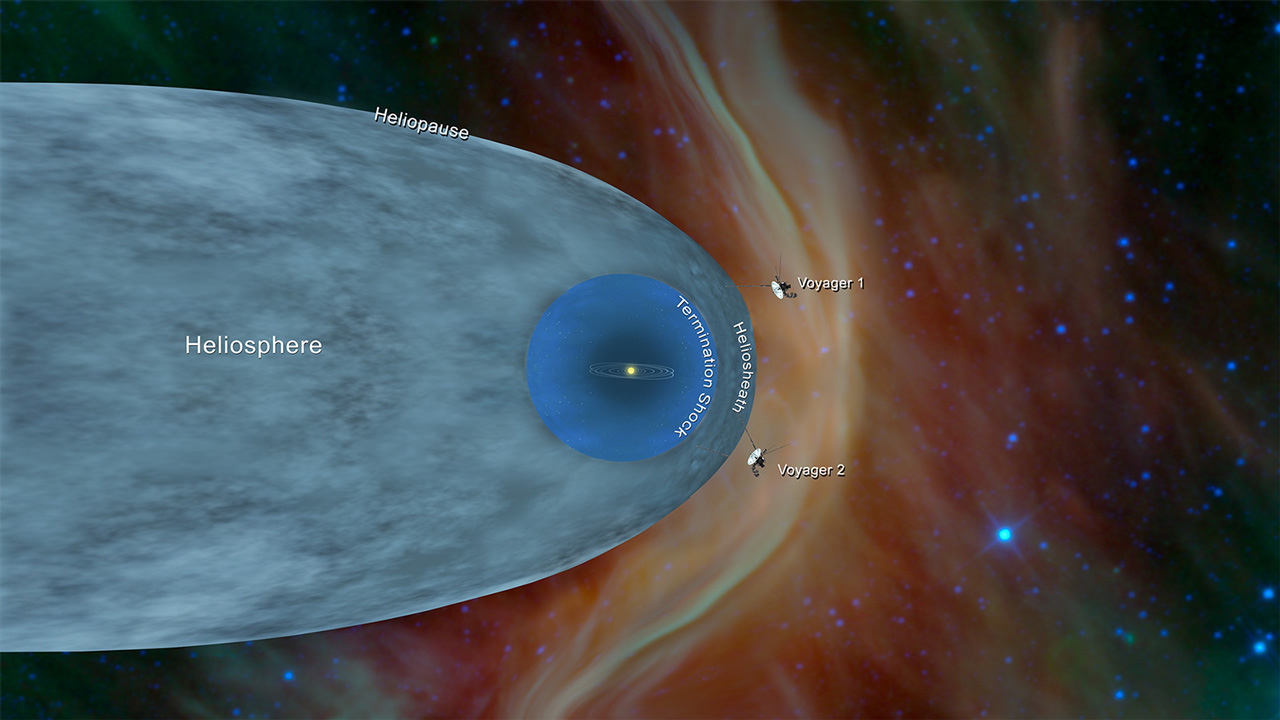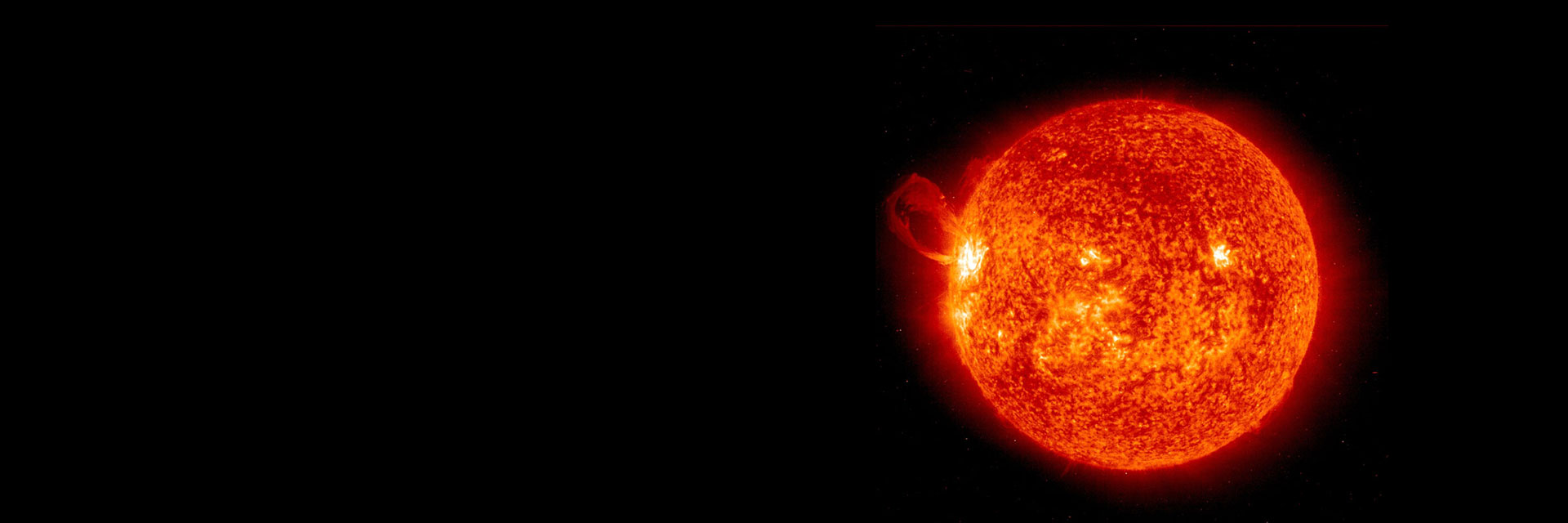Expanded from question two of the big three heliophysicist investigative questions: How do the Earth, the solar system, and heliosphere respond to changes on the Sun? Learn more ›
Our heliosphere is a vast bubble of plasma – a gas of charged particles – that spews out of the Sun. This outflow is known as the solar wind. The bubble surrounds the Sun and stretches beyond the planets. Both Voyager spacecraft had to travel more than 11 billion miles (17 billion kilometers) from the Sun in order to cross the edge of the heliosphere. This bubble is moving through interstellar space as the Sun orbits the center of the Milky Way galaxy. As our heliosphere plows through space, it creates a bow wave, like the wave formed by the bow of a ship.

Best Practice! Using Guiding Questions to Drive Inquiry
Each big idea has student-friendly questions written at different levels that you can use to guide inquiry-based investigations at the appropriate level. Explore this big idea at each level below, with featured resources you can engage learners with.
Introductory Learner
Guiding Question: What is the heliosphere?
Standards: ESS1, ESS2
Heliophysics Narrative:
- Earth has spheres (land, water, air, living things) and Earth is part of the Sun system, called the heliosphere. Most systems are inside the Earth, but the heliosphere is all around Earth and the entire solar system. The heliosphere is the region of space that is influenced by the solar wind, and other particles from the Sun. It is everything that the Sun touches!
- At this level students are building a more complex view of how Earth's systems interact with one another (5-ESS2-1), and know that Earth orbits around the Sun (5-ESS1-2).
- Connect to the Sun by introducing the heliosphere into students' model of Earth's systems. While the heliosphere is not explicitly identified in the standard, it is implied because none of Earth's systems could exist without the Sun. The heliosphere is defined by the reach of the solar wind (energized particles from the Sun), and not simply by the reach of the Sun's light or heat. While conceptualizing solar wind at this level is not appropriate, you can make an analogy with Earth wind in that we can't see wind, but we can still measure it.
- Extend student exploration by examining the extent of the heliosphere. The heliosphere extends out into space 123 Astronomical Units (AU) from the Sun, far beyond Pluto, which is only 39 AU from the Sun. Make sure students understand what an AU is. It is defined by the distance of Earth from the Sun, which is 93 million miles (1AU = 93 million miles, or 150 million km). Consider adding the heliosphere to a scale model of the solar system.
- Support younger students by having them think about things they observe in the Earth system, like water (hydrosphere), air (atmosphere), plants and animals (biosphere), rocks and mountains (geosphere).
- Challenge students at the next level by having them investigate NASA missions that have studied the boundary of the heliosphere (IBEX, Voyager).
Featured Resource: IBEX Mission Heliosphere Infographic & Activity ›
Intermediate Learner
Guiding Question: How does the Sun create space weather on Earth?
Standards: ESS2, PS2
Heliophysics Narrative:
- Space weather is caused by the Sun and encompasses a wide range of phenomena that occur in the heliosphere, which include changes in the solar wind, coronal mass ejections, solar flares, and other types of particle and radiation (storms). As space weather activity intensifies, Earth's magnetic field becomes more disturbed, which we refer to as geomagnetic storms. These storms can interfere with communication satellites and other technology on Earth. Solar flares can produce high energy particles that disrupt electrical circuitry in satellites. Coronal Mass Ejections (CME) can cause electrical power outages.
- At this level students learn about the properties of Earth's interior (MS-ESS2-1) and that Earth's magnetic field can extend out into space (MS-PS2-5).
- Connect to the Sun by introducing the term, "space weather," and supporting a model for Earth's systems that includes, not only radiation input from the Sun, but also how the solar wind interacts with the Earth's magnetosphere and atmosphere. Because our satellites reside in low-Earth orbit, which is within the ionosphere, so monitoring and predicting space weather is important to keeping human infrastructures safely working.
- Extend student exploration of space weather by having them investigate how the sunspot cycle correlates with aurora sightings.
- Support beginner students by revisiting how Earth's systems interact with one another (5-ESS2-1).
- Challenge students at the next level by having them investigate the properties of plasma, which is what the solar wind is made of. Plasmas and magnetic fields interact to produce a wide range “space weather” phenomena.
Featured Resource: What is space weather? ›
Advanced Learner
Guiding Question: What is the difference between the space around the Sun (the heliosphere) and the interstellar medium (the space between stars?)
Standards: ESS1, PS2
Heliophysics Narrative:
- The region of space influenced by the Sun's constant flow of material (solar wind) and its magnetic field is called the heliosphere. Interstellar space, or the space between stars, is not completely empty, but is made up of gas (primarily hydrogen (H) and helium (He) left over from the Big Bang) and dust. We call this the interstellar medium. The boundary between the heliosphere and interstellar medium is not rigid, but varies with the changing Sun.
- At this level, students are learning about the contents and scale of the local universe (HS-ESS1-2). At this level students are continuing to make observations about the effects of changing magnetic fields (HS-PS2-4, 5).
- Connect to the Sun by emphasizing that the heliosphere is in pressure balance with the interstellar medium. This equilibrium determines how far away from the Sun the boundary of the heliosphere, called the heliopause, is located. When the solar wind is dense and fast moving, the heliopause is farther away from the Sun than at other times. Which explains why the boundary is not rigid.
- Extend student exploration by examining the properties of the heliosphere boundary. Two NASA missions have studied this boundary, IBEX and Voyager. IBEX images the boundary from its orbit around Earth. The Voyager mission, however, launched in 1977, was the first spacecraft to leave the heliosphere and enter into interstellar space (2012)!
- Support beginner students with reviewing the mechanics of pressure. You can use the analogy of the flow of water through a garden hose. If you have more water, moving faster, you have greater water pressure; if you have less water, moving slower, you have less water pressure. The solar wind produces pressure in the same way, acting against the interstellar medium to push it farther away from the Sun.
- Challenge students at the next level by having them further investigate the interstellar medium closest to our solar system, in which astronomers have identified significant regions of space that have distinct properties, called the “Local Bubble” and the “Local Fluff.”
Featured Resource: NASA’s Heliophysics Fleet: Voyager Mission Homepage ›
What level are my learners?
Introductory: A younger learner (K-5), or a learner new to the subject matter.
Intermediate: A middle-aged learner (6-8), or a learner that has some familiarity with the subject matter.
Advanced: An older learner (9-12+), or a learner that has a lot of experience with the subject matter.
Note: Next Generation Science Standards (K-12) are mapped to the resources accordingly.
What is a NGSS Heliophysics Narrative?
NGSS Heliophysics Narratives support educators with the incorporation of heliophysics concepts and resources into their existing curricula. The narratives consist of relevant heliophysics background information, applicable NGSS performance expectations, and guiding questions to spark inquiry-based learning at the appropriate level.
Narrative Structure:
- Short answer to the question, for teacher background knowledge
- An analysis of NGSS Performance Expectations (PE) to determine learning constraints at each level
- Heliophysics topics that connect to the NGSS PE and can be infused into teaching systems science
- More heliophysics to explore
- How to support beginner learners
- How to challenge learners at the next level





